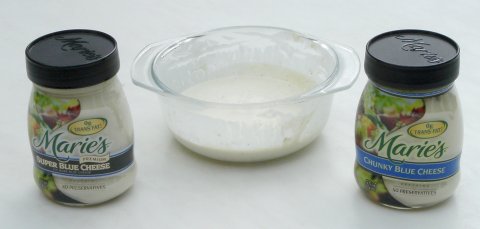« Reading List: The Language Police |
Main
| Music: Delightful Reggae Covers from Vanuatu Band »
Wednesday, May 31, 2006
SubMarie's: Preliminary Comparison Tasting

In the description of my
attempts to reproduce Marie's Blue Cheese salad dressing, I mentioned that, to date, I had been guided only by my memory of the original; I hoped to be able to make a direct comparison of my recipe with the bottled product eventually, but an opportunity to do so had not yet presented itself.
From my recent trip to the U.S. (here are a
few, rather odd, pictures), I was able to bring back two bottles of the Real Stuff: one of the original “Chunky” recipe and one of the “Super”, which contains (according to the package) 25% more blue cheese. I made up a batch of my “current best practice” recipe, let it age a couple of days to allow the flavours to meld, and compared them, initially by tasting small quantities directly from the bottle (or dish), and then on iceberg lettuce.
Initial evaluation? First of all, I have new respect for the experts who do comparison tasting of recipes. The power of suggestion is great in the human brain, especially in the deeper, more visceral parts associated with taste and smell. Just as one can persuade oneself that an
audio clip is almost anything at all, the perception of flavour is strongly influenced by expectations, and the difficulty of comparison is magnified further in “chunky” recipes where each taste differs from the next. But still, one must judge, so here's a tip of the tongue report. In retrospect, I had underestimated how “mayonnaise-ey” the original Marie's recipe is. My approximation is much closer to the “Super” recipe, which I had never tasted before this comparison, than to the original which I gobbled regularly so many years ago. The difference between my recipe and the Marie's Super (to the limited extent of my discernment), is that the French Roquefort cheese I used is more strongly flavoured and more salty than the provenance-unspecified blue cheese used in the Marie's product. The difference is subtle: it's much more obvious when tasting the dressing directly than when served on a salad, and the distinction is more evident when the bit you're tasting contains a chunk of the undiluted blue cheese, not just the sauce. The
whole-grain mustard I'm using appears to be ground more coarsely than the mustard flour and bran in Marie's, which gives the concoction a slightly speckled appearance kind of like Breyers vanilla ice cream, if you remember that (good grief—it appears to
still exist; who'd have guessed?), and a very slightly “crunchy” texture. I don't find this at all objectionable, but if you do, substituting finely ground mustard powder should do the trick.
Where do we go from here? Well, for those of us who simply want a recipe for great blue cheese dressing, I consider the problem solved. Having the three to compare side by side, I consider the “Super” Marie's recipe better than the original “Chunky” I tried to reproduce, and the difference between that and my recipe barely distinguishable in a direct comparison and entirely negligible when served on a real salad or as a dip for
crudités.
Still, I am an engineer, and attention to detail summons me back to the laboratory or, in this case, the kitchen.
The first obvious thing in the taste testing is that the blue cheese used in Marie's is substantially less strongly flavoured and less salty than the Roquefort I used, which can result in ambiguous results in taste testing of chunky recipes until you discover that the integrated taste of a spoonful depends on how many chunks of the straight cheese made it into your mouth. This is something which one can address only by changing the blue cheese in the recipe. I have laid in a supply of different kinds of blue cheese readily available in Central Europe, and I will taste them and try different recipes based upon them according to my evaluation of their similarity to the blue cheese used in the Marie's recipe.
Second, I will develop a “watered-down” or, more accurately, “mayonnaised-up” recipe which attempts to better approximate the original Marie's recipe. As these experiments progress, I'll report results here and eventually add the resulting recipes developed for variants to the
SubMarie's page. For regular use
chez Fourmilab, however, I'll almost certainly stick with the current
recommended recipe.
Posted at May 31, 2006 22:27

